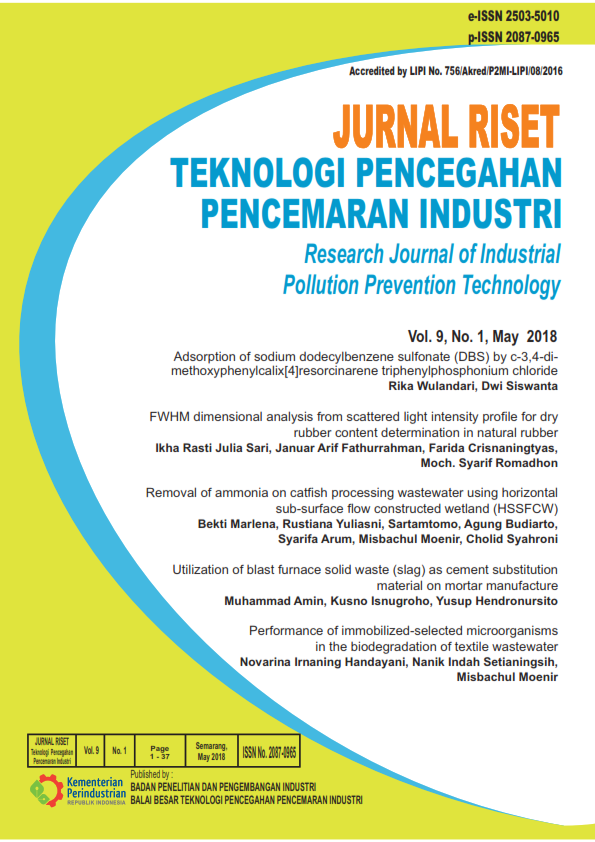Utilization of Blast Furnace Solid Waste (Slag) As Cement Substitution Material on Mortar Manufacture
DOI:
https://doi.org/10.21771/jrtppi.2018.v9.no1.p22-28Keywords:
slag, substitution, cement, physical test, compressive strength, materialAbstract
Slag is defined as a waste material produced from iron ore smelting process in blast furnace. The slag was derived from Research Center for Mineral Technology located in Tanjung Bintang Lampung Selatan with particle size of 80,100, and 120 mesh. The percentages of slag used as cement substitution were 10%, 20%, and 30% from total volume. Test pieces was made by compressing all mixture material in 50 x 50 x 50 mm cubical mortar mold. Physical test of mortars, such as : porosity test, density test and compressive strength test were performed. Based on physical test of samples, it was shown that the higher ratio of slag used in cement substitution gives higher mortar porosity. Substitution of 10% slag with size of 100 mesh produced the porosity of 3.45%, while the substitution 20% and 30% slag with the same size, produced 5.08% and 5.76% porosity, compared with the standard of mortar which was 5.12%. The compressive strength test with 10% slag substitution was 19.3 Mpa, while 20% substitute slag gave the compressive strength of 19.1 Mpa and 30% substitute slag has compressive strength value of 18.7 Mpa. The standard mortar is 17.2 Mpa. However, beside of slag substitution ratio, the slag particle size also affected the compressive strength and porosity. Based on the results explained, the substitution of slag as a substitute for cement in mortar strength was still above the mortar standard.References
Hasanudin., 2015, kimia dasar.com/proses- pembuatan- besi (diakses tanggal 9 Agustus 2017).
Hish am M., Khater M., and Hamdy A Abdel Gawwad., 2015, Characterization of alkali activated geopolymer mortar doped with MWCNT, Journal of Silicate Based and Composite Materials, 67 (2), 38-47.
Josephson G W., Sillers F., and Runner DG., 1997, Iron Blast Furnace Slag: Production,Processing, Properties, and Uses, Wasington, D.C. US. Bureau of Mines Bulletin.
Lewis, D.W, 1982, Resource Conservation by Use of Iron and Steel Slag, New York: ASTM SpecialTechnical Publishers.
Mitsufuji, Shiroishi, and Tanaka., 2000, Devloment of Consolidation Inhibitor for BF Slag Fine Aggregate for Concrete: Material & Process Procedings of the Symposium of the Iron and Steel Institute of Japan, Japan.
Muhammad Kadhafi, 2015, Pemanfatan Copper slag sebagai subsitusi semen pada campuran beton mutu K-225, Jurnal Teknik Sipil dan Lingkungan 3 (1): 734 -740.
Mulyono T., 2003, Teknologi Beton, Andi Offset, Yogjakarta.
Murdock LJ., dan Brook KM., 1990, (Alih bahasa Stepanus Hendarko), Bahan dan Praktek Beton, Penerbit Erlangga, Jakarta.
Nawy EG., 1996, Reinforcement Concrete a Fundamental Approach, 3rd edn. Preintice Hall, Upper Saddle River, New Jersey.
Nofrizon., 2009, Pemanfaatan Slag Baja Sebagai Subsitusi Pasir dan Semen Pada Pembuatan Mortar, Tesis Magister Sistem Teknik, Universitas Gadjah Mada, Yogjakarta.
Paul Nugraha Antoni., 2007, Tenologi Beton, Andi Surabaya.
Salain AK., 2009, Pengaruh Jenis Semen dan Jenis Agregat Kasar Terhadap Kuat Tekan Beton, Jurnal Teknologi dan Kejuruan, 32 (1), 63 – 70.
SNI, Standar Nasional Indonesia, SNI – 03-6825-2002: Metode Pengujian Kekuatan Tekan Mortar Semen Portland Untuk Pekerjaan Sipil, ICS 27.180, Badan Standardisasi Nasional.
Widojoko L., 2010, Pengaruh Sifat Kimia Terhadap Unjuk Kerja Mortar, Jurnal Teknik Sipil UBL, 1 (1), 52 – 59.
Downloads
Published
How to Cite
Issue
Section
License
Copyright (c) 2020 Muhammad Amin, Kusno Isnugroho, Yusup Hendronursito

This work is licensed under a Creative Commons Attribution-NonCommercial-ShareAlike 4.0 International License.











